Centscreen shenanigans! - Sharing a few custom screen modes from my assorted Falconry.
It’s your (least?) favourite writer on atariscne.org, back to torment, or possibly entertain you, with some more thoughts formed into words on a topic of (hopeful) interest.
This time, I have spent some time on the quest to increase my screen real-estate area from the lowly Atari official offerings for VGA on both my CT60 and Centurbo 2 Falcons. The tool to accomplish this is the screen booster, Centscreen, from Rodolphe Czuba, the creator of the famous accelerator boards mentioned just above.
I won’t go into the long history of Falcon developers deciding the original ‘baked in’ screen mode options provided by Atari Corp were somewhat lacking and creating their own third party solutions to un-hobble the mighty Videl. It’s a bit like CPU accelerator cards and overclocking boosters, which also seemed to be available almost from day one.
The tool that did it for me was Centscreen. I’ve already had a long acquaintance with Centscreen and its screen mode creator app, CentVidel. This goes back to the time when I first got my CT2 fitted, many years ago. It wasn’t too much of a hassle to get set up, once I worked out what I was doing. Some quite generous bigger screens could be made. An 800 x 600 GEM desktop was quite normal for me. The giddy heights of 1024 x 768 were reached.
When my CT60 first came along in 2003, it was initially easy to transfer my existing CT2 settings to it. A patched CentVidel (thank you Evil) enabled me to make some more custom screen modes for it. This was needed as I had to ‘downgrade’ to a 20 MHz clock, from a 25 MHz one, to stabilise the system.
A lot of time has passed, memories are hazy. With the imminent return of the rejuvenated CT60 in the summer, it was time for me to get to grips with the subject afresh.
Taking a look at the Centurbo 2.
I started with a refresher class for my Centurbo 2 Falcon. It had always had Centscreen installed there, but lately that seemed to be working poorly, with the custom screen modes previously created refusing to work properly. It could have been early symptoms of a general aging and decline of the hardware. It might not have taken well, with old settings, to a new and unsympathetic monitor. After I had a proper look at the instructions, it actually turned out that the autoboot ordering had got out of whack, with Centscreen not being where it should have been.
A quick Autosort later and suddenly Centscreen started to behave properly again. I deleted the rubble of past custom screen modes made for long-lost monitors and started afresh. It has a 25/50 MHz bus boost, so the better of the two options, with more possibilities to play around with.
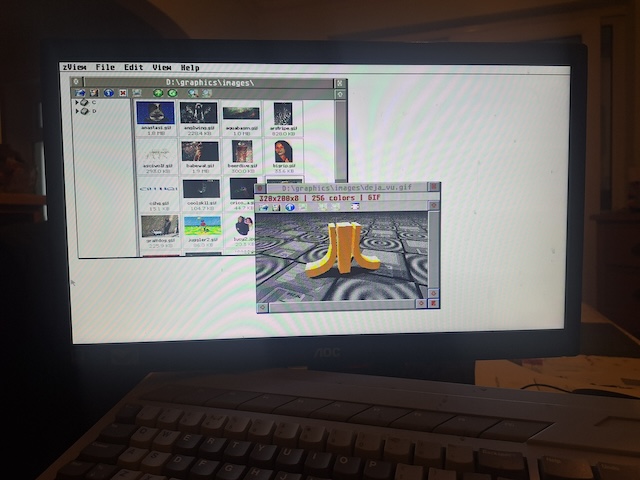
1024 x 640 - Where 25 MHz makes it possible.
Getting an 800 x 608 screen was easy. The next step was a 1024 pixel width adjacent screen mode. After a little experimentation, I settled on a 1024 x 640 mode for 256 and 16 colours. This mode, apart from putting a little less stress on the Videl, manages to eliminate the mildly annoying pixel stretching you get on a wider aspect ratio screen. Presumably the firmware for a modern screen can comfortably lock onto it. For comparison you can get to a 640 x 480 truecolor classic VGA screen with relative ease, but in that case, stretchy horizontal pixels are noticeable.
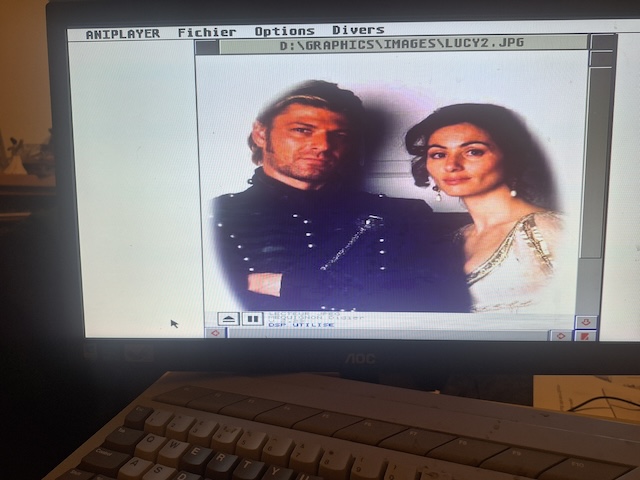
It's a wide 640 x 480 truecolor screen. You monitor mileage may vary.
No, I don’t have any oldschool CRT screens, to attempt any crazy maximum record weird odd-numbered pixel display, which works triumphantly for 7 or 8 minutes, then something overheats and you hear the faint dying screams of the Videl. It’s just boring cheap commodity SVGA flat screens all the way here.
Next, the CT60 returns.
I repeated the exercise when my CT60 returned home.
This was boosted on a 20/40 MHz clock, so more restricted than for the Centurbo 2. Before I even opened CentVidel, I found a 640 x 960 interlaced mode already present in my Centscreen settings. Tried that, quickly retreated back to a safe 640 x 480 screen. It was like the fugly 320 x 480 official Atari VGA Truecolor mode, but on a grand scale!
The first place to start was with my usual 256 colour mode. I realised I wasn’t getting to 1024 x 768 territory, but the vicinity of 800 x 600, maybe?
I got close enough. A stable and happy expanded screen beamed back at me in 800 x 576 resolution, Good enough there. I’ve had no issues with stability, so I think I’ve managed to keep things sensible there.
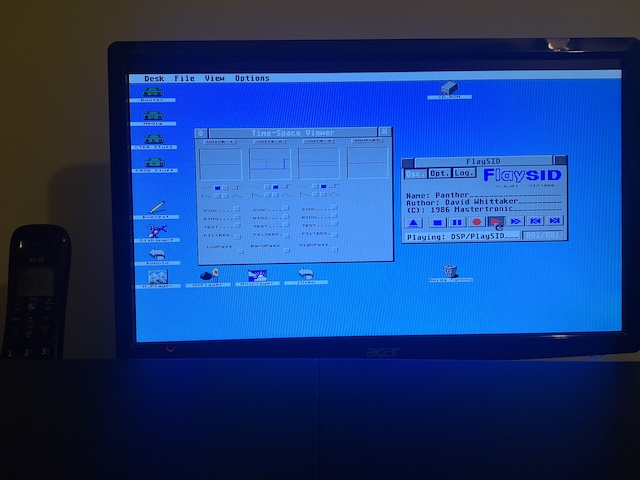
With a 20 MHz bus (CT60), some compromises need to be made, but 800 x 576 is okay.
So I repeat this for the 16 colour mode, all fine. Now, what can we squeeze out of Truecolor mode?
I’m not getting to 640 pixels width. I know that already. I think that even on a 25/50 MHz bus, you’re pushing things to breaking point going much past that. However, after some *careful* playing around within CentVidel, I ended up with a decent compromise 560 x 528 pixel truecolor screen.
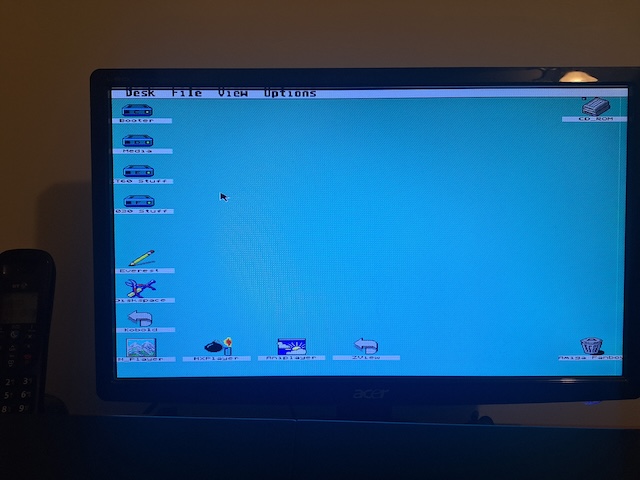
Free at last, of the dreaded 320 x 480 VGA Truecolor mode!
Well that seems to be good enough. A bit cramped if you’re seriously working with big documents or image files (who does these days?) but certainly good enough for media viewing applications such as movie and animated GIF playback.
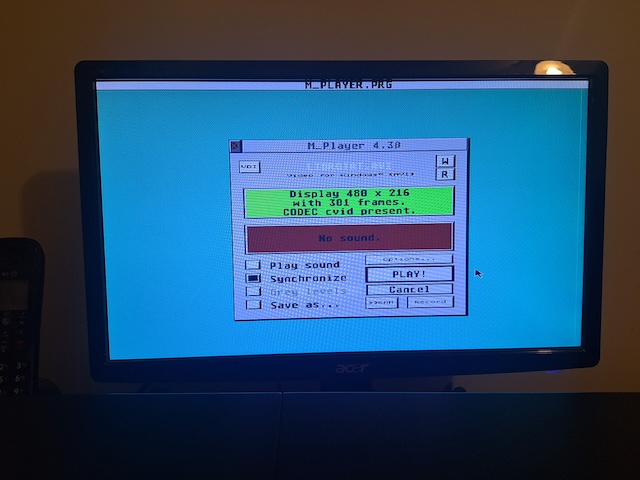
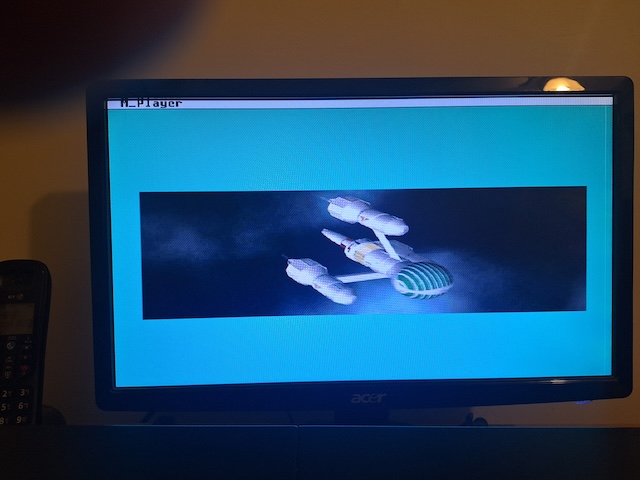
Good enough for any of my Falcon AVI movie conversions.
For comparison, here’s a photo I took of the same movie on Aniplayer and Centurbo 2 with the available 640 x 480 Truecolor mode there. This displays comfortably and animates convincingly, but check out the cpu usage! Wheezy or what?
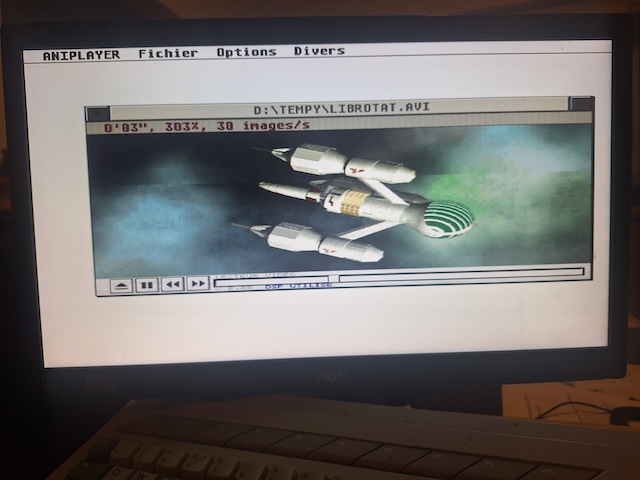
This comes across decently on my Centurbo 2 as well.
So in conclusion.
In the absence of a SuperVidel or other graphics card. Screen booster software, such as Centscreen, in conjunction with a suitable bus speeder mod, is still a quick and convenient way of expanding your Falcon’s screen real estate. Even after all these years have passed.
It has also been a useful exercise to give the neglected 20/40 MHz booster some love. Most discussion about screen enhancers skips straight to the 25/50 MHz users, with nothing said at all about the lower setting. This article proves that you can get quite a long way with Centscreen, even with the lower bus speed.
Reassuringly, my aged brain has managed to reacquire the fundamentals of getting my better screen modes going again. So if I can manage it you shouldn’t have any issues either.
CiH - Sept 2025 for atariscne.org





Comments
I seem to recall that Centscreen disables the Xbios Vsync() call. Perhaps it was an old version though.
I think I may even have acquired one of those at some point in the past.
I always got on well with Centscreen, so saw no reason to try anything different.
I did some experiments back then with 25MHz bus and different TC modes but it depended a lot on having a decent 60ns RAM card or it was uninvited sparkles or maybe whole disappearing pixel columns :) I remember 640 was possible at 25MHz but 512x384 - or something close - at 20.
Didn't really try out Centscreen but maybe we had in-house bias with Dave's Videlity ;) probably Centscreen deserves a visit finally.
So most of the time for practical use it was a 20MHz bus in 2..16 cols - and I think it was some weird 832x or 816x size. Whatever didn't explode my monitor at the time (which of course would have been a big goldfish-bowl 'flat' CRT). When writing code it doesn't matter how many colours we can get it's all about the page scroll speed so we always end up in mono modes
So now we just need to find the fabled 8bit chunky mode and we can go through it all again :)